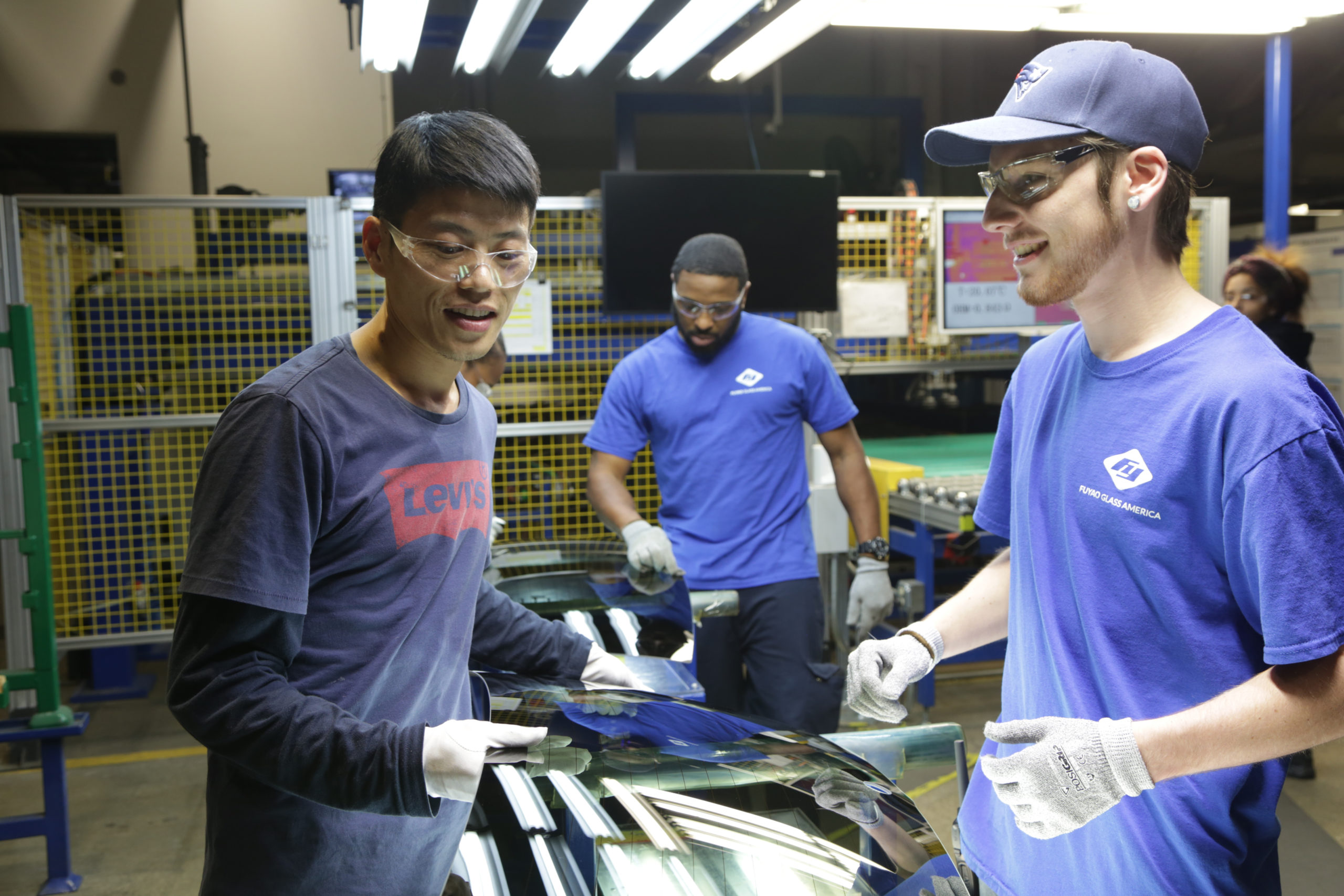American Factory
(USA, 115 min.)
Dir. Steven Bognar, Julia Reichert
Programme: Special Presentations (International Premiere)
Is there any hope left for the American dream? The prospects for the land of the free look pretty dire in the outstanding American Factory. The doc offers an immersive and penetrating look into the plight of the USA’s working class. The film is the latest work from director Julia Reichert, this year’s Outstanding Achievement Award honoree at Hot Docs, and if it’s the first time that audiences have heard of the filmmaker, it should prove an excellent introduction to an overlooked body of work. (Reichert shares directing credits with Steven Bognar, and it’s easy to see why they took the director prize at Sundance this year.)
The directors go deep into the American Heartland where disgruntled and destitute workers cast their ballots for Trump who hope to regain their jobs they lost as factories closed and the economy collapsed. The doc takes audiences specifically into the Fuyao Glass America factory, where a Chinese manufacturing tycoon resurrects the site of an old General Motors plant in Dayton, Ohio with the aspiration of bringing back jobs and prosperity through an international endeavour. Cultures and values collide as the American workers, initially rejuvenated by the prospects of regaining their jobs, security, and independence, struggle to connect with Fuyao’s wholly un-American work ethic. Glass shatters frequently in American Factory, and the shards offer one of the most apt metaphors of the American dream that one may ever see.
American Factory demands comparison to Barbara Kopple’s Oscar-winning masterpiece American Dream with its frank and laudably objective portrait of the USA’s working class and its struggle for prosperity. (And given my esteem for Kopple, this is about the highest praise I can give a film.) The two films would probably make an excellent double bill as they both go into the trenches of American industry to reveal the deep social and economic divides that convey how the American dream is something to which everyone may aspire, but few can ever achieve. While Kopple’s doc entered the Hormel Foods meatpacking plant as workers took to the picket lines in an effort to unionize when the company reduced hourly wages despite posting a $30 million profit, Reichert and Bognar’s film observes the genesis of the labour struggles that lead to a similar confrontation between blue collar and white collar workers.
American Factory quickly tells audiences about the plant’s closure and the devastating job losses that affected the community. However, it initially offers an optimistic look as Fuyao sets up shop and promises to be the first incarnation of an international endeavour to aid the USA’s economic recovery. The filmmakers gain access to employees throughout all lines of work at the company, and they share the hardships they faced at the loss of GM. Stories include enduring three years of unemployment, lost homes, and liquidated self-esteem. The return to work is bittersweet as the frontline workers reveal that they’re returning to the factory on severely reduced wages. (One woman says she’s now making $12 per hour when similar work at GM paid $29.) Similarly, there is cautiousness in the air as the employees return to the factory with the floor offering a notably different demographic: as part of Fuyoa’s international endeavour, a sizable portion of the workforce is Chinese.
The film is immensely fascinating as Reichert and Bognar capture the perspectives of workers both American and Chinese. Each demographic has preconceptions about the other, and many of the prejudices are transformed as the working relationships progress. The Chinese see the Americans as fat, slow, whiny, and lazy, but change their tunes when they realize that many of the workers have to take another job the moment their shifts at Fuyao end. Similarly, some workers express resentment at the fact that Chinese labourers are taking American jobs, but they soften their stances when they learn that the Chinese have mostly left their families back home for two years and rarely enjoy days off work in an effort to make more money and increase the factory’s productivity. The film offers an invaluable lesson on the importance of diversity in the workplace and the benefits of creating an exchange as people from different walks of life interact and share perspectives.
At the same time, the film can’t help but observes the major culture clashes that suggests that the Fuyao endeavour sounds too good to be true. For one, Fuyao’s chairman, Cao Dewang, doesn’t show much concern for American regulations or protocols. His inaugural tour of the factory is quite humorous as he whines about the aesthetics of a smoke detector and blames the building’s poor feng shui on the US manager’s inefficiency. (The manager helplessly replies that fire codes dictate its height and placement on the wall.) Cao then nitpicks about the placement of a garage door and demands a restructuring of the building that will cost $65,000 for mere cosmetics. The conditions on the factory floor dismay the American workers and inspectors, who recognize that Fuyao treats safety regulations as soft advisories (at best) and doesn’t follow the standards for protocol or waste management. Injuries and worker disenchantment abounds.
The greater clashes, however, are ideological and philosophical. The Americans struggle with the realization that Fuyao sees employees not as people, but as sprockets of a machine. The Chinese industrial character, which favours mass manufacturing of cheap goods of lower quality, doesn’t jive with the Americans’ pride in producing quality products. The formula to make Fuyao a success simply can’t translate when transported to a different country.
The doc humorously underscores the cultural divides when a group of American employees visit the Fuyao headquarters in China and witness firsthand the rituals of depersonalization and assimilation that encourage the workers to see themselves not as individuals but elements committed to the company’s overall success. The Chinese factory is awash in propaganda in signs, posters, messaging, videos, and even a full-fledged industrial musical show for the employees on Chinese New Year. The Americans watch with a fix of awe and astonishment as the propaganda machine works in full force to indoctrinate the employees. Efforts are made to transport the propaganda to the Ohio plant, but morale only decreases.
Similarly to Kopple’s American Dream, American Factory gives fair weight to people at the management level. It follows Cao Dewang as he tours the factories on both sides of the globe and, at first, his intentions truly seem noble. He makes a point of walking the floor and shaking hands with his American employees to welcome them, and advises his senior staffers to adopt American ways and follow the philosophy of “when in Rome.” However, Cao is vehemently anti-union, which creates some riveting drama when the goals of the company clash with the reality of the American workplace. As the American workers rally and the Fuyao brass retaliates to keep the enterprise a reality, American Factory observes the futility of the American dream in a society ruled by capitalist endeavour. Touring the factory floors proves an emotional rollercoaster for a viewer as one experiences the highs and lows of the workers as they are taken for a ride on this stillborn dream.
Reichert and Bognar’s film profoundly holds up a mirror to contemporary society and asks audiences what they value: their happiness or their wages. At the heart of the film is the futile mantra of “making America great again” as the employees reflect on their dashed hopes and disenchantment. What arises is the realization that the great America of yore simply no longer exists. How can one even define greatness for the working class in 2019?
American Factory screens:
-Tues, Apr. 30 at 6:00 p.m. at Isabel Bader
-Thurs, May 2 at 10:30 a.m. at TIFF Lightbox
-Sat, May 4 at 6:00 p.m. at Isabel Bader
-Sun, May 5 at 4:15 p.m. at TIFF Lightbox











